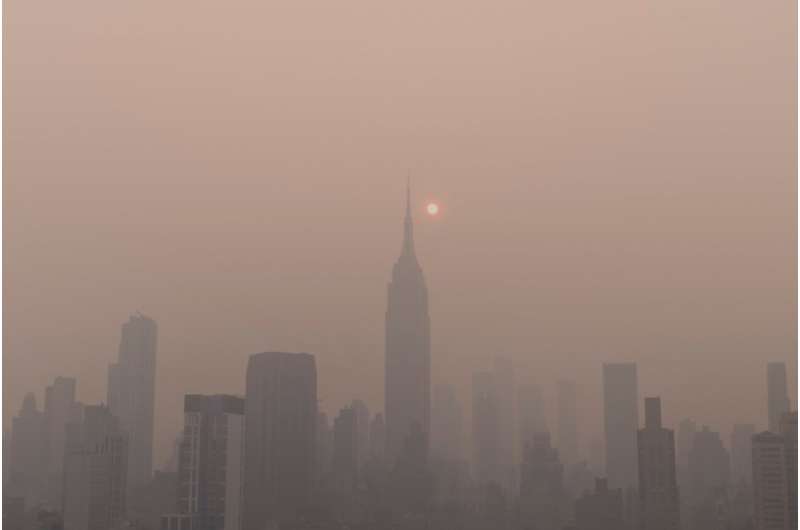This article has been reviewed according to Science X's editorial process and policies. Editors have highlighted the following attributes while ensuring the content's credibility:
fact-checked
trusted source
proofread
Ending the 'false argument' about whether we should adapt to climate conditions or work to mitigate climate change

Nobody can argue that this summer was one for the weather record books, with NASA declaring July the hottest since records have been kept, smoke from Canadian wildfires wafting into the U.S. and a massive blaze killing more than 100 people in Hawaii.
But weather disasters inevitably lead to heated debates over the cause and what to do about them.
Is the problem global warming and climate change or poor land and forest management?
Is adapting to current and future climate conditions admitting defeat? Do weather disasters—which have existed as long as there's been a planet Earth—all stem from climate change?
Northeastern distinguished professor of civil and environmental engineering Auroop R. Ganguly calls these "false arguments" that delay the creation of solutions to a rapidly changing environment.
Both adaptation to changing climate conditions and mitigation of the causes of climate change are necessary for the safety and security of people around the globe, Ganguly says.
"This kind of connection gets lost a little bit," says Ganguly, who is co-director of Northeastern's Global Resilience Institute.
An ideological divide
He says over the years there's been an "unfortunate ideological divide… where either a person talks about greenhouse gas emissions reduction needing to happen or a person says engineering management designs will stop or reduce these (disasters)."
The reality is millions of people are in harm's way from a growing number of extreme weather events, Ganguly says, so working to reduce fossil fuel use, as promoted in the Inflation Reduction Act, needs to go hand in hand with adaptation strategies designed to protect lives and infrastructure.
As an example of the divide, a Wall Street Journal editorial this summer castigated clean energy advocates for blaming the Canadian wildfires that blanketed the Northeast on climate change.
The Journal editorial said the wildfire-driven release of the greenhouse gas carbon dioxide into the atmosphere would offset the reduction in fossil fuels and blamed wildfires on poor forest management, such as restrictions on prescribed burns.
While some environmentalists oppose controlled burns, U.S. Forest Service officials and others increasingly espouse prescribed burns to keep forests healthy.
'We have the tools'
It's important that the public and governments accept a two-pronged approach of adaptation and mitigation as scientists develop more sophisticated tools designed to promote resilience of "human settlements and critical infrastructure," Ganguly says.
"We have or are beginning to have much better tools and methods for predictive understanding and for risk analysis," he says.
The tools include simulation models, nature-inspired design such as floating mats of vegetation to combat erosion and the use of artificial intelligence and machine learning to better predict precipitation and floods.
Communism, or neocolonialism?
In the United States, climate change denial is associated with people with a more conservative, right-wing view of politics.
"They say climate change is a big communist or socialist plot to take our money and give it to others," Ganguly says.
But in his travels across developing countries including India, Nepal, Indonesia, Brazil and Tanzania, he has seen people with a leftist point of view describe mitigation efforts as "neo colonialism."
"They say, "People from the West come in and say you have to reduce your emissions when our carbon footprint per capita is so small,'" Ganguly says.
That sort of thinking can be offset by having the community come up with its own individualized solutions to changing climate conditions, says Puja Das, a fourth-year Ph.D. candidate in interdisciplinary engineering at Northeastern's Sustainability and Data Sciences Lab.
For instance, while the Netherlands has accommodated rising sea levels and more extreme precipitation events with vast, open floodplains, population-dense Bangladesh has responded to increased flooding by putting houses on stilts.
"We have to be adaptive to what we want to do based on each country," says Das, who is from Bangladesh and in May delivered a talk on flood management before a United Nations committee.
'Prepare for what is coming'
"But we also have to be prepared for what is coming," she says. "We have to make our infrastructure ready."
Das is traveling to Oak Ridge, Tennessee, this month to visit the Tennessee Valley Authority for a NASA-funded project to refine precipitation forecasts.
Better forecasting would give the TVA, which controls more than 150 dams, better lead time to decide whether to open or close dam gates, for instance, Das says.
"Hopefully, this will save lives," she says.
"We have these tools and approaches," Ganguly says.
To lack understanding of the complementary roles of adaptation and mitigation "diminishes our ability to save lives, to save property and to reduce these kinds of hazards so we can live in a world which is more environmentally friendly and sustainable."
Provided by Northeastern University





















